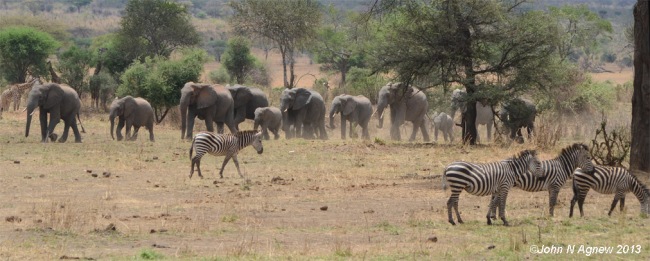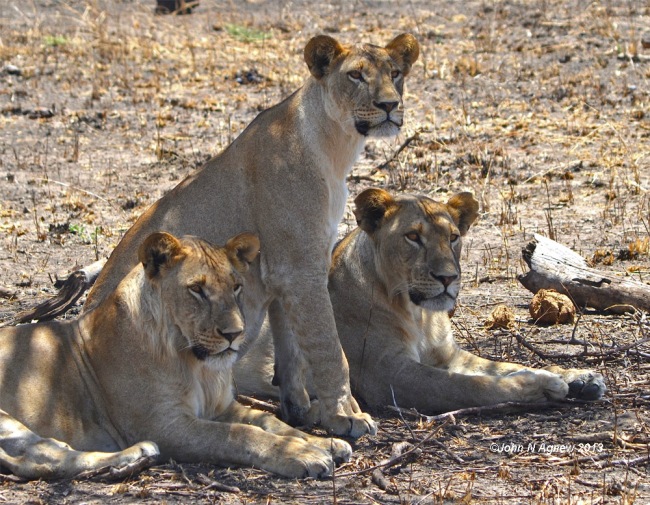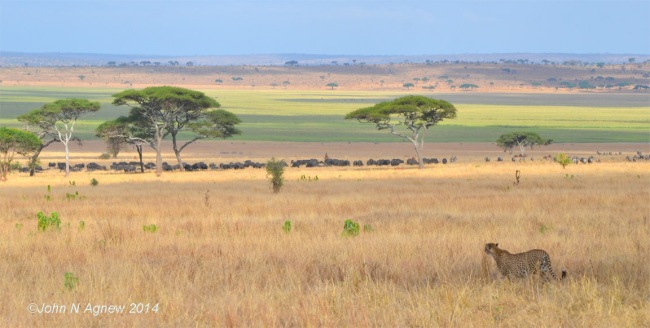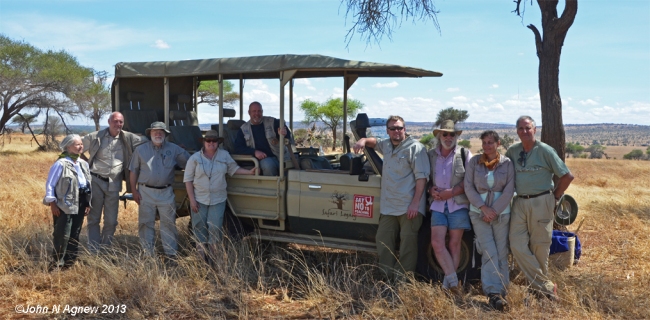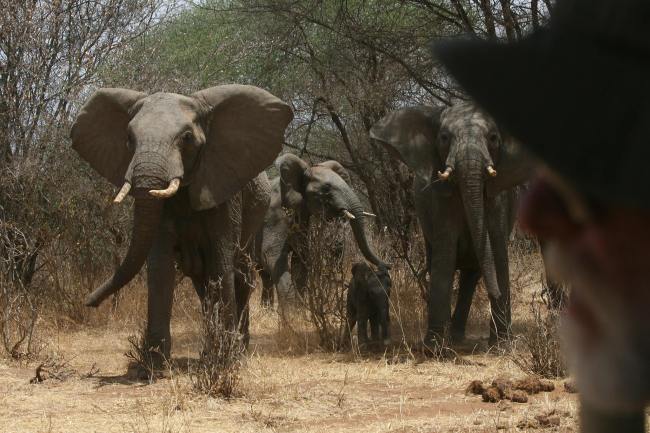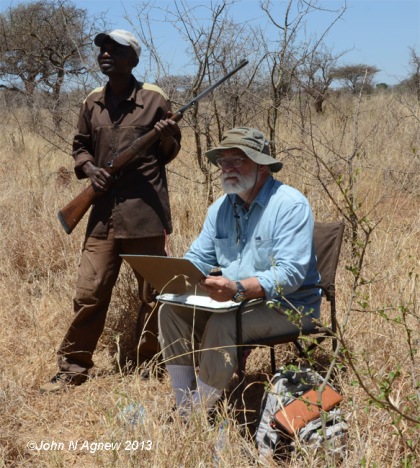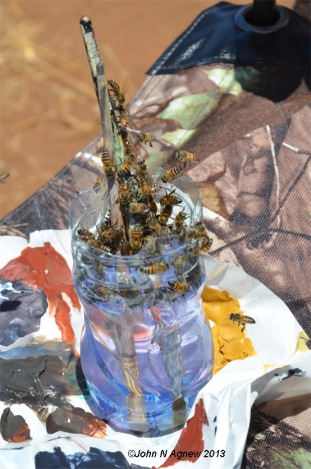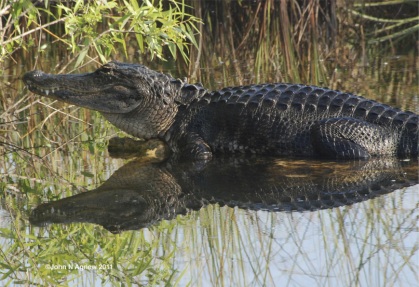Filed under: Adventures, Art News | Tags: Africa, Elephants, Lions, painting in Africa
As an artist, I have had little interest in Africa. It is partly the hundreds of nature films about the continent, or most likely, it is the hundreds of paintings I’ve seen of African animals that have jaded me. Just being a painting of an African animal made it a cliche to me. I had gotten to the point that I just wasn’t interested in looking at another zebra or lion, no matter how well they were portrayed.
Going there changed everything. I knew it would, but experiencing such a place is a mind expander. This gets back to the fact that an emotional connection to the subject is the real inspiration to do a work of art. Not quite like falling in love, but a personal experience that is significant enough to make you want to express your feelings about it.
This definitely happened to me during my trip to Tanzania. Getting within a few feet of a pride of lions was an experience that brought tears to my eyes. Close enough to hear them sigh, to smell them, to have them look into my eyes (that was actually a bit disconcerting).
This same experience was repeated numerous times with many different species. Then there was the overwhelming majesty of it all. To look out over a spectacular landscape and see five or six species of large mammals, all at once and some of them in huge herds is just awesome, in the most appropriate meaning of the word. Meanwhile, behind you is a family of mongoose, and there’s an eagle, and oh, I see a python in that tree… it just doesn’t quit!
The purpose of the trip, however, wasn’t just to wow us. I was part of a group of nine artists from four countries that banded together to do what they could to help stop the slaughter of elephants.
Artist Ambassadors Against Poaching: R-L Sandy Scott (USA), Tony Pridham (Australia), John Agnew (USA), Jan Martin McGuire (USA), James Hines II (USA), Robert Louis Caldwell (USA), Paul Dixon (South Africa), Julie Askew (UK), Dale Weiler (USA)
Our intention is was to experience wild elephants (and everything else), produce art works about elephants and sell them to raise money for elephant conservation. Specifically, the money will go to the African Wildlife Trust, an NGO in Tanzania formed to fight elephant poaching. Money will go to rangers for vehicles, radios and weapons, among other needed supplies. An impromptu auction on Facebook of sketches and small paintings raised over $2,000. A future exhibit at the Hiram Blauvelt Museum of Art will raise much more! Watch for details and dates.
Experience wild elephants we did. Sometimes we experienced them a bit closer than we had planned, such as the group of females and young that we surprised as we drove around a corner in our open safari vehicle.
That’s my face on the right, as we were charged by the female elephants with young. They were pissed because we surprised them, and they let us know. The rumble of running elephants, combined with the sounds of pissed-off elephant screams is quite enough to get your heart beating faster. Fortunately, Auntie on the left stopped short of our vehicle, and the rest of them then stopped as well. They could have easily destroyed our vehicle, and likely us with it. Most of our encounters with elephants were much more peaceful, sometimes even friendly. I won’t bore you with the 3,000 images I took of elephants, but watch for some of them to appear as elements of future paintings. I took nearly ten thousand photos on the two week trip, not at all unusual for photographers in Africa, especially in this digital age that makes multiple photos easy and cheap. Others on the trip took twice as many photos as I did! I used a Nikon DLSR (D7000) with a 70-300mm lens as my primary. Changing lenses in the field was to be avoided at all costs, as it was an extremely dusty environment (end of dry season in late October).
I also painted in the field with artists Jan Martin McGuire and Julie Askew. There was certainly no shortage of subject matter for “plein aire” painting (painting outdoors). However, it wasn’t quite the same as painting “en plein aire” at home, as there were roaming lions, Cape Buffalo, and other dangerous animals. Our guides insisted on armed escorts while we were on the ground outside the vehicle.
That’s Thomas with a .454 rifle, powerful enough to stop a charging elephant (god forbid). There was a pride of nine female lions in the area where we were working, so the rifle was not just a prop. However, Thomas and our driver spent most of their time sleeping in the vehicle as we painted. As it turned out, we were harassed by bees, not lions. Some local honeybees discovered our paint-water jars, and soon the entire hive seemed to be enjoying the new water source. We had to construct a decoy out of a plastic water bottle that we cut in half with a Masai spear. This kept most of the bees busy away from our painting spot.
Filed under: Adventures, Ivory-Billed Woopeckers | Tags: Bruce Creek, Choctawhatchee River, Ivory-Bill, Ivory-Billed Woodpecker, Ivory-Bills
I returned to the Choctawhatchee basin in the Florida panhandle in February, with the Cincinnati group lead by John Ruthven. The last time I had been there was 2010, when we froze in the swamps, sometimes breaking ice as we launched our kayaks. I missed last year’s expedition as it conflicted with my term as Artist in Residence at Everglades National Park. This year, the mild winter spared us the frozen mornings of the last trip. We had near perfect conditions, although the water was about 6 feet lower than during my last visit. This limited boating to stream channels, as the swamps were nearly dry. This enabled us to hike further than we had on other trips, and we found some promising habitat for Ivory-Bills.
We had no sightings and heard no double knocks, but we did find some trees with tantalizing evidence of large woodpeckers foraging. Ivory-Bills like to use their beaks as chisels to pry off bark from recently dead young hardwoods. The tip of the beak is even flattened like a chisel, and we hear it leaves a mark like someone used a screwdriver to pry the bark off. Pileated woodpeckers can also leave similar horizontal marks, but they aren’t supposed to have the same sharp-edged grooves that Ivory-Bills leave.
One area in particular had a tree with some very hard-edged grooves, and the general habitat matched the description given to us by old timers in the area who claim to have seen the bird several times over their lifetime. They tell us, “You boys are spending too much time down in those river swamps.” Of course, we’ve had some success in river swamps…. myself and another in our group, Sally Woliver, had a good sighting in 2008 of a male Ivory-Bill along Bruce Creek, and Geoff Hill’s gang has made several sightings in the Choctawhatchee basin, mostly along stream channels. What the locals have told us, though, is that the IBW’s prefer upland swampy valleys surrounded by hardwoods. The spot where we found this tree fit that description. On Google Earth, you can see a horseshoe-shaped cypress/gum swamp, with mature hardwoods all around. We walked out on an old logging road through the hardwoods until we encountered the swamp forest, and found several trees within a 100 square yard area that had been worked on by possible Ivory-Bills. Unfortunately, we found this place on the last day, so a more detailed investigation and “stake out” will have to wait until next time.
Here are a few sights from the trip to the Choctawhatchee River basin:

Bill Hopple and Lester Peyton of the Cincinnati Nature Center confer with Devere Burt, Director Emeritus of the Cincinnati MUseum of Natural History
I was Artist in Residence at Everglades National Park this January, and although I spent a lot of time doing plein aire paintings, I also shot nearly 3500 photographs. Many or most of these will become references for future paintings, but some are art in their own right. I apply the same composition techniques, the same color balance rules, etc. The big difference is that I have no control over nature. Much of photography is a combination of skill and luck– being in the right place and time with the right intentions. Of course, as painter I have total control, and can change things that I don’t like, but much of my painting is first visualized in the camera. I might find a landscape that lends itself to a well composed photo, sometimes a stage for some creature. I use the scene in a painting only after I have reconfigured it to suit my needs. In this way, photography is a passive art discipline, recording what we find, as opposed to painting, where we create everything from “scratch.”
Sometimes my photos are of something unusual or striking that I find in nature… often these same subjects would look too perfect, too contrived to become a painting. As a photo, we might look at it and say, “How unusual,” but as a painting, we would probably say, “That doesn’t look correct.” We accept photos as a record of reality (not so true anymore), while a painting must portray our expectations of reality.
So, I suppose that my photography and painting are blended in a way. I use the camera as a visualizing tool. I parse the images I see in nature through the viewfinder. I’m also a photo-realist. I don’t copy photos directly, but I need all of that visual information to make the scene accurate. In other words, I’m not making anything up, just rearranging things to suit my imagination and artistic sense. It is all accurate, even if the overall scene came from my imagination. This need for accuracy has its foundations in my career in natural history museums as an exhibit designer, illustrator, modeler and muralist.
I’ve completed my second stint as Artist in Residence, this time in Everglades National Park. What a great place to be in January, especially if you’re from the north. The locals were complaining about how chilly it was down there… but 68° felt pretty nice to me. It was 5° in Cincinnati when I was packing the car for the trip to Florida.
So, three weeks with nothing more serious than, “Where am I going to paint today?” This is a wonderful situation for an artist who normally works in a studio or at home and is constantly interrupted by the daily requirments of business or family. And, in a tropical “paradise” no less.
Now, some folks might not consider the largest swamp in the country to be paradise, with it’s requisite mosquitos, alligators and snakes, but it is for me (except for the mosquitos). I happen to love alligators and snakes, and if you’re familiar with my art you already know that. The Everglades are a unique subtropical habitat, full of life and offering some sublime landscapes to paint and admire.
Because this was the dry and cool season, mosquitos were almost absent, and the temperatures were pleasant (especially compared to home). This would not be the situation in the summer months, when it would be impossible to do plein aire painting in the Glades without some sort of air-conditioned space suit. The mosquitos become so thick in the summer that a person can literally choke on them… this is no exaggeration… and the temperature and humidity hover in the range of 90°/90%. The only place comparable would be the arctic tundra, where the mosquitos get almost as bad in the summer (but not as hot).
However, I was there in the pleasant season. I spent many blissful hours sitting at my easel in very delightful wilderness settings. I finished ten plein aire paintings, and took nearly 3,500 photos. I’ll post some of my better plein aires here, and also check my Facebook page and website. All the plein aire paintings are for sale, in the $350-450 range. I’ll be producing some studio paintings (more expensive) from this trip in the coming year or two. I will be exhibiting both studio and plein aire works at the Earnest Coe Visitor Center at Everglades National Park in 2013.

"Panther Tracks" 11" x 14" acrylic on masonite. Painted on location, north of the main park road near the Pinelands area. There were panther tracks on the road where I painted... I kept looking over my shoulder as I worked.

"Florid Bay #1" 11 x 14 acrylic on Masonite. This scene changed dramatically while I worked, going from foggy and high tide to sunny and low tide over the three hours I painted. In the summer months, the mosquitos would have carried me off from there.
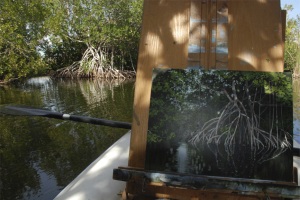
Painting from my inflatable kayak. It's a bit cramped, but I can rest the easel on my lap and a paddle and be reasonably comfortable for a couple of hours. In this spot, however, I was shadowed by a large American crocodile that I dislodged from its basking spot. It surfaced behind me while I was painting. I heard it take a breath, which caused me to turn around quickly, which made the croc take off with a splash that rocked my boat! .
I spent last week down in the Choctawhatchee River area, looking for Ivory-Bills with a group including members of my art group, Masterworks For Nature, the Cincinnati Zoo, and Miami University (OH). While we had a large group, we were spread out every day up and down the Choc, exploring various tributaries including Bruce Creek. Some people were heavily camouflaged and sat waiting in likely places. Others explored for IBWO sign, looking for new areas for future stake-outs. The Cincinnati Zoo’s videographer, Pat Story, made a documentary of our trip, and we plan to have an art show at the Cincinnati Zoo based on our experiences on the Choctawhatchee (dates to be announced). We experienced record cold while there, seeing ice in the swamps, shivering through the teens in the mornings, and a chilly 50 degree high most days. It did make it to 70 on our last day. Sigh.
We saw no Ivory-Bills, and no definitive sign. Hanging out with this group, some of whom have spent quite a long time in the field looking for this ghost, gives me a better sense of what the common experience of Ivory-Bill hunters is like. After all, I got spoiled by seeing the bird up close and personal in the first 24 hours of my very first attempt. This trip was more like the usual effort–no evidence found. Some of the more hard-core experienced types were shaking their heads wondering if it is really worth the effort. I thought it was interesting that they gave me a nod when I was present, but then went back to their skepticism. My sighting is not proof to anyone but me. It was too clear, too in-my-face to be a mistake, but it isn’t proof. I’ll keep going back to look, but I fear I missed what will likely be the only chance I’ll have to get a clear photo of this ghost.
I believe our chances will diminish as time goes on. A major airport is being constructed nearby, and will add a lot of noise to the area when air traffic ramps up. As the airport is developed, sprawl will begin to spread towards the Choctawhatchee. As more people move into the area, more weekend warriors, ATV riders, and even bird watchers will descend on the Choc. Despite the abundance of good habitat at the moment, disturbance and habitat degradation may eventually chase the Ivory-Bills elsewhere.
The current issue of Bird Watcher’s Digest (Jan.-Feb ’10) has my article about my sighting of the Ivory-Bill back in ’08. It also has an ad for the print of my painting recreating my sighting. 20% of the purchase price will be donated to Dr. Geoff Hill’s (Auburn University) project on Bruce Creek and area. National Geographic has helped them with specialized robot cameras, which may be our best chance of catching the Ivory-Bills on “film.” If you’re interested in the print and helping out, see my website at: http://www.johnnagnew.com Check the “Prints and Books” section.
What a way to experience a national park. Doing “plein air” painting in wonderful natural settings is just an incredible way to really soak in the essence of a place. I just finished 3 weeks as Artist In Residence at Pictured Rocks National Lakeshore (in Michigan’s Upper Peninsula), and it feels as if it has been burned into my memory. Staring intently at a scene for hours, deconstructing it in your mind and reconstructing it in paint is a good way to make a pretty firm visual memory of a place. I also experience and visualize places through photography, but it is just not as complete a way to incorporate a place into yourself as painting can be.
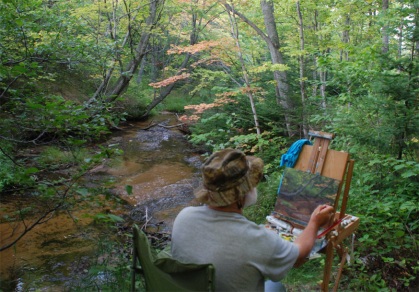
A day at the office. Working on Au Sable Creek
We were provided an old farm house as housing, and were quite comfortable. My normal way to experience a national park is by camping. That can be a lot of fun, but there is a lot to be said for a kitchen, a shower and a bed at the end of a long trail. Maybe it’s because I’m edging toward the far end of my fifth decade that the ground just isn’t as comfortable as it used to be. Maybe it’s the modern conveniences in the kitchen. Anyway, this trip might have spoiled me. I’ll be applying to more parks.
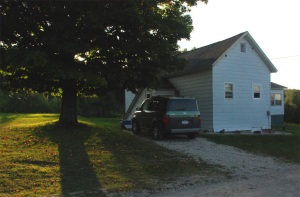
Home, sweet home during my stay at PRNL
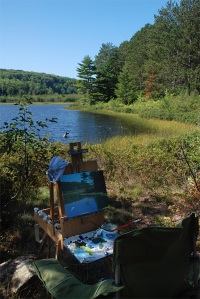
My typical set-up, with a chair and my French easel. Nice view from my office, don't you think?
Being comfortable, well fed and well rested probably boosted my endurance. I’m usually ready to head for the barn after a week or two in a tent, but I gladly spent the entire 3 weeks painting happily on a trail somewhere in the park. It was just idyllic. The park staff kindly provided perfect weather, and everywhere we looked there were paintings waiting to be done. The commute to work every day began in the car, but quickly switched to trail or kayak. Traffic was generally light. Typically, I’d find a spot and sit down to paint while Pat took off on a trail. She covered over a hundred miles during my 3 weeks of painting. After Labor Day, we saw so few people out in the park on trails or beaches that it began to feel like our own private park. It’s true that I normally pick out of the way spots so as to avoid people while I work. It is not so much that I am annoyed by people talking to me, but it is an interruption of limited time. When people do talk to me, I often continue working, which might appear rude to some. Painting in spots that keep me isolated allows me to concentrate more fully, and remain “in the zone” if there is one for painters. The one disadvantage of working in isolated spots is the increased chance of surprise wildlife encounters. Having a bear look over my shoulder while I’m working would be a bit disconcerting, although my usual encounters are more benign and welcome (not that I don’t like bears). I’ve been visited by otters, eagles, deer and other fascinating creatures. Sitting quietly in one spot is a great way to see wildlife, as many hunters will tell you. After a long day in the wilds and after supper, we’d head back out for an evening on the beach watching the sunset, or listening to the coyotes and wolves singing at the rising moon. When the moon waned and disappeared from the evening sky, we could see the Milky Way in its full glory, and even our nearest galactic neighbor the Andromeda Galaxy, visible without a telescope (2.8 million light years away!). It was a hard job, but…

Sunset on Lake Superior
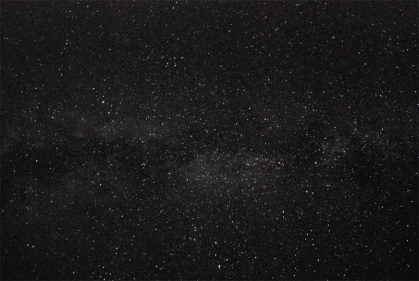
The Milky Way, a 30-sec exposure
The results of my artistic efforts were mixed. I was pretty happy with about half of the 12 paintings I produced in the 19 days of work. Paintings of stones, a successful studio series inspired by Pictured Rocks, were not so successful as plein air paintings. I did better with landscapes and water.
On September 23, I gave a program to the public and park volunteers. I displayed the paintings I had finished during my stay, and lost my best efforts to sales and a donation to the park. This is the eternal curse of the artist; having to repeatedly sell your favorite children to make a living.
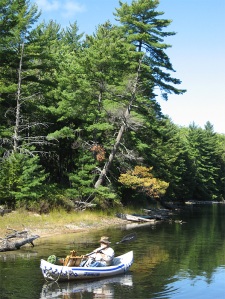
My commute to work, traffic was light.
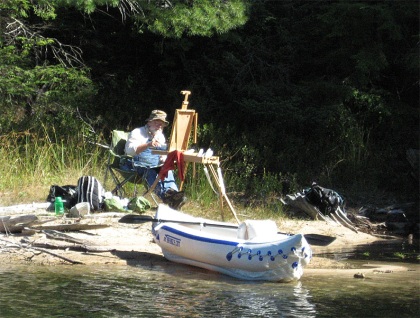
My "studio" at Legion Lake. What a way to make a living.

"The Coves" 14 x 11 acrylic on panel

"Au Sable Creek" 11 x 14, acrylic on panel

"Au Sable Point" 11 x 14 acrylic on panel. A misty gray morning on the point. That's the lighthouse poking above the trees in the distance.
I wasn’t surprised at our lack of success at Bruce Creek last March, as it is more like the typical experience of Ivory-Bill hunters. Had I seen a second one in my second attempt, everyone, including me, would wonder about my sanity as well as my veracity. This is one of the rarest birds in North America. Why would we expect it to be easy to find? Also, I hear that there has not been much activity noticed in the area since last spring (’08). No double knocks have recorded recently, no “kent” calls, and no sightings. It would seem the birds have moved elsewhere or hunkered down in their nest cavities. We talked to a local guy who has lived in the area for 60+ years. He has seen the bird numerous times, and thought we were spending way too much time in river swamps. He says that most of his sightings were in upland hardwoods. We talked to another younger man who was fishing at the Bruce Creek landing, and he also said he has seen more IBWO’s in the upland valleys. They both identified the correct woodpecker picture .
Skeptics point to the lack of any credible photographs as a sign that we’re on a wild goose chase. On my last visit to Bruce Creek, I decided to make a “serious” attempt to photograph a Pileated Woodpecker, which were abundant and obvious in the area. It was close to impossible to get a clear view of one from a distance, and those that came close were visible for only a second or two, hardly enough time to get off a shot with the camera. Had I been better prepared last year, I might have been able to snap a photo, but focus would have been very difficult, as the bird was coming at me. Auto focus just does not work in such a situation, with a background of branches and leaves. Chances are I would have missed or botched the shot. Of course, just tooling around in a kayak with a camera is not a truly serious attempt to get a photo. Geoff Hill and group have improved their camera traps with seismic triggers and higher resolution. They have captured Pileated Woodpeckers, so it only seems a matter of time before they get an Ivory-Bill. Other photographers have set up with extreme camouflage and professional equipment, but so far have just picked the wrong spots to wait.
I’m confident that someone will turn up something concrete in the near future. There are a lot of determined amateurs out there, so some one is bound to get lucky and stumble on a IBWO, as I did, but get the photo too.
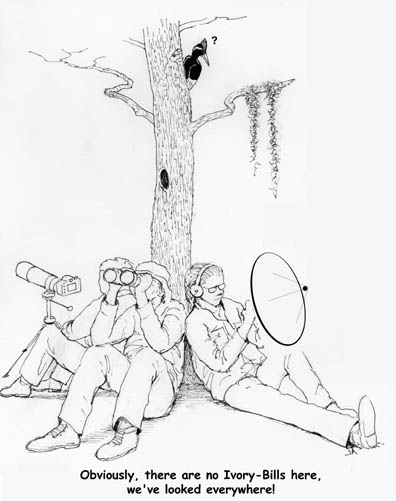
I’ve been a caver for 37 years. Maybe longer if you count my childhood tendencies to crawl into dark places. For those not put off by the darkness or bats, caves have that something that excites the instinct to explore. Explore we have, mapping many miles of dark tunnels and crawlways under the green hills of Kentucky. For me, it wasn’t just about the thrill of discovery. Caves are an aesthetic experience, like underground sculpture galleries. The limestone is scalloped and fluted, and corroded into a swiss-cheese maze, sometimes decorated by fantastic crystalline ornaments.
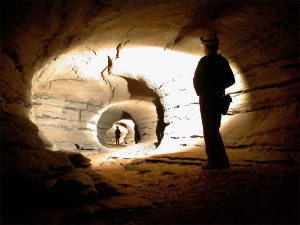
Wells Cave, an 11 mile system in southern KY
There is also the time-capsule factor. Because caves have no weather (if they are above flood stage levels), whatever changes made by visiting animals or humans last for tens of thousands of years. I’ve seen 4,500 year old footprints left by prehistoric Indian explorers and 10,000 year old tracks left by an ancient Jaguar in a Tennessee cave. I’ve seen 1,000 year old Mayan storage jars in Belizean caves that still contained corn cobs a couple of inches long, the ancestors of todays foot-long ears.

1,000 year old Mayan storage pots in a cave in Belize
I was once shown a pit in a cornfield in Yucatan by a Mayan friend. I rappelled into the 50ft pit, feeling pretty high-tech with my modern climbing and caving gear (sandals and candles are standard Mayan caving gear). On bottom, I found myself standing on a pile of debris in the middle of a flooded passage. I couldn’t proceed without swimming, so I looked down to see if I could spot any potshards. It was then that I realized I was standing on a pile of human bones! These were likely the victims of a battle that occurred here (the late Post-Classic city of Mayapan) several hundred years ago. I climbed back up the rope, using my mechanical ascenders that grip the rope and allow you to climb without risk of losing your grip and falling. I got to the top and found that a crowd of Mayan spectators had gathered. I sat on the lip of the pit while I derigged myself, and then clumsily dropped one of my ascenders into the pit. I cursed myself and prepared to do the climb all over again to retrieve the ascender, when a Mayan stepped forward, said “No ay problema,” and slid down the rope bare handed. He clenched the ascender in his teeth, and shinnied back up the rope in seconds. I feebly thanked him as he handed me the ascender. So much for feeling superior for possessing hi-tech gear.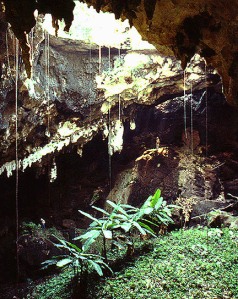
Nowadays I don’t do much of the hard-core exploration, crawling for miles, climbing hundred-foot pits, or spending 20 hours underground. That stuff is better suited for 20-somethings. I suppose I could lose some weight and whip myself into shape so that I could once again suffer for exploration, but my interests lie more in finding imagery. A casual stroll with a camera and tripod are more to my liking. Of course, there is rarely such a thing as a casual stroll in a wild cave. Cameras have to be packed in waterproof boxes and handled carefully to prevent their destruction by dust infiltration. To find caves free of trash and graffiti means going to places that have “nerd filters” as they are called in the caving parlance. These filters are usually deep pits, or tight, long and difficult crawlways. Things to discourage the casual caver, which I would like to be most days. I guess we do have to suffer for our art. See http://www.johnnagnew.com for examples of my cave art.
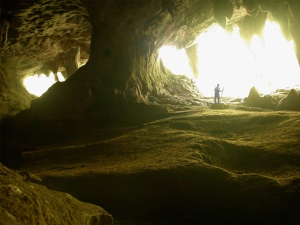
A burial cave in Sarawk, Malaysia (Borneo)

Filed under: Adventures
I have a small garden pond in my city backyard (I’m 5 minutes from downtown), but it is an oasis of wilderness. My favorite creatures that inhabit the pond are the frogs. There are Green frogs (Rana clamitans melanota), and Bullfrogs (Rana catesbeiana). The Bulls dominate the pond, eating everyone but the largest Green frogs. In fact, they eat everything that can fit in their mouth. I have seen Bullfrogs with 8-inch goldfish hanging out of their mouth, eating Goldfinches and sparrows, and even attacking (unsuccessfully) Mourning Doves. I once watched a hummingbird dodge a frog that launched himself straight up to catch the little bird. The hummer “stepped” aside like a matador, and the frog flew past with an open mouth. I have since read that Bullfrogs are the major predator of hummers. A hummingbird would only be a small, feathery snack for a big frog.
The best part of having frogs in the yard is their croaking. As soon as the evening air is warm, they begin the choruses of “Jug-O-Rum” (Bullfrogs) and the out-of-tune banjo pluckings of the Greens frogs. Loud noises seem to stimulate singing, like jets overhead or trucks rumbling by. I sometimes stand out there and croak at the frogs, getting them to talk back. Of course, my wife and my neighbors just think I’ve finally lost it. As mating time approaches, the males do combat like little sumo wrestlers. They go belly to belly, trying to push their rival over. They also try to jump on top of each other. There is a lot of competition for the choice nesting spots, usually at the base of some emergent plants like bullrush or water iris.
Last year I got to watch a green frog lay her eggs, with her attendant male hanging on in amplexus. The eggs spewed out in a couple of seconds, and the little white centers darkened quickly. The eggs hatched in just a couple of days, with tiny little black tadpoles wiggling free and sinking into the depths.
The pond is about five years old, and I’ve had a couple of crops of tadpoles make the metamorphosis. It takes two summers for the tadpoles to mature. Unfortunately, the adult frogs seem to love the taste of new frogs, so a lot of them get gobbled up before they’ve eaten their first bug. Garter snakes also take a toll, but that’s nature, and I enjoy seeing the snakes as much as I do the frogs. I get a thrill out of seeing a garter snake glide across the pond just as I would seeing an anaconda in the Amazon. You take your thrills where you find them.
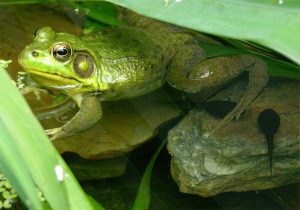
A male Green frog with last year's tadpoles
Of course, the pond and its frogs are a great source of images for my artwork. Ponds and their reflections are endlessly fascinating. The frogs give it some personality.

"Waterlily and Frog" 8x10 acrylic on panel
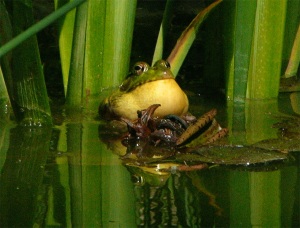
A Green Frog singing in my pond
Filed under: Adventures
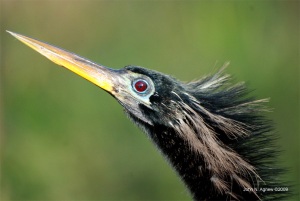
Anhinga at its namesake trail.
I used to live in south Florida and visited the Glades quite often back in the late 70’s- early 80’s. It was my introduction to tropical ecosystems, and as a life long reptile lover, something of a “holy” place for me. After reading of the adventures of famous herpetologists there, it was really exciting to see it for myself.
We went back this past January, after an absence of nearly 20 years. It was a very nostalgic trip, but we couldn’t help but feel that the place had diminished somewhat. Some of our favorite trails were closed because of storm damage, and we noticed even more exotic invasive plants. Although we didn’t see one for ourselves, Burmese Pythons have become a scourge since our last visit. I’ve read of extensive mercury contamination of the Park waters. It is no longer healthy to eat fish from the Glades.
Still, we saw much of the beauty we expected to see. The vistas of vast sawgrass prairies are still there. The great pine savannahs are still there. Even some of the huge old mahogany trees in Mahogany Hammock have survived the hurricanes that blasted through the park in the last 20 years.
The bird life concentrated at the usual spots (Anhinga Trail, Mrazek Pond) was still in evidence, and I got some wonderful reference photos.
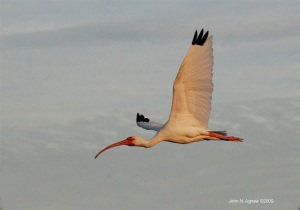
White Ibis in the light from sunset
However, I read that birdlife in the Glades is only 20% of what it was in the 80’s! Back in the 80’s, I read that the bird life was only 10% of what it was before man intervened around the turn of the last century. That’s pretty discouraging. There are efforts underway to restore the Glades to some of its former glory, but money and politics still get in the way. An effort by the state of Florida to buy up sugar cane fields south of Lake Okeechobee has been much reduced by the recent economic downturn. These lands are critical to restoring the flow of clean water into the Everglades. For me, the place is still a wonderful source of images. Inside the Park, the vistas haven’t changed much, and I can find truly sublime visions.
Gators have always been an interest of mine, and they give the place a very Cretaceous-like aspect. Cypress and alligators go all the way back to those Mesozoic days, although the cypress were in Canada back then.

An alligator at Shark Valley
Back in our early days of visiting the Park, I searched for the American Crocodile. In nearly seven years of trying, I never did see one. On this recent trip, I spotted five in one morning. It’s nice to know that something there is making a real comeback. I also got to see a cottonmouth. I never managed to find one before, although I knew they were around. It was a beautiful specimen, looking freshly shed and very colorful. It was lying in the middle of the main park road, a very risky basking spot. I tried to encourage it to leave the pavement, while steering traffic around the snake with my flashlight. As cars passed, I’d illuminate the snake so they could appreciate my efforts. I wish I could have heard the comments.
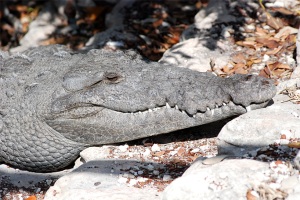
The head of a 10-foot American Croc basking near the docks at Flamingo
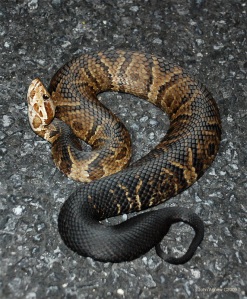
A Florida Cottonmouth on the main road.
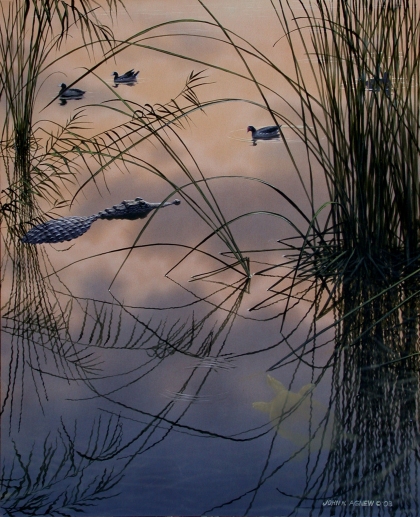
"Everglades Morning" is currently on display in the US Embassy in Costa Rica.

